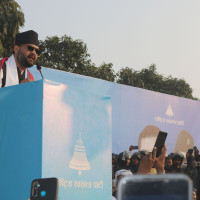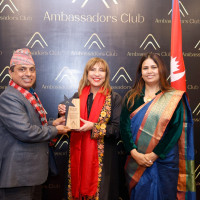- Tuesday, 20 January 2026
The glitter of ‘Pote Market’ endures for centuries
By Dikshya Koirala,Kathmandu, July,1: The beauty of Kathmandu lies in the pleasure of little discoveries. At every intersection of this ancient city, you will be greeted by the sight of small temples made of wooden and brick structures, with intricately carved windows and doors. On a stroll around the valley, you will come across narrow alleys that lead you to a courtyard where a flock of pigeons circle a gilded stupa. One of these pleasurable discoveries in Kathmandu is the centuries-old “Pote Market”.
Indra Chowk is a bustling financial hub and main street of downtown Kathmandu. This street snuggled at the centre of the city is situated between the halfway point of the Asan and the historical centre of Basantapur. In one of the intersections adjacent to Indra Chowk, you will discover the Pote Market that is more than 350 years old.
“Pote” is a collection of small glass beads garland worn by married Brahmin/Chhetri women. It is also used by women of other communities like Gurungs in festivals like Loshar. The back side of the Pote Market is called Wang: Gha. Here, you see stone-carved statues of different gods and goddesses. This location is identified by the three stone pots. It is believed the original name of this place was Gha, which in Newari refers to three stone pots.
The history of this market goes back to King Pratap Malla who ruled Kantipur from 1641 AD to 1674 AD. During his rule, Kantipur was successful in extending its border on both sides and earning a monopoly over trade with Tibet. The construction of the majority of buildings around the Basantapur Durbar Square was done during his reign.
The current site of the Pote Market was once said to be the banks of a river where funeral rites were held. The river changed its course over time, but the Hindus refused to occupy the area which once was used as burning ghat by their forefathers. King Pratap Malla consulted a priest and was told the land would bring luck to people who wrote from right to left. Following this, the Muslims from Kashmir were brought to settle here and they have stayed in the area for generations crafting beautiful jewellery back then for royalties and for everybody these days.
These days, when religious violence is raising its head in different parts of the world, with the past decade experiencing a sharp increase in religious tension, these small alleyways have not been perturbed by such strife with the Muslim traders given due respect and shown tolerance for centuries now.
Satish Kapali, 34, a local shop owner, said, “Hindus and Muslims living here have a generational bond. Culturally and festival-wise, we are intertwined. The local Muslim residents in this area are called Newa Muslim. We are like brothers. We local Newars get the title Banshaji title in our citizenship (decedent citizenship), and the Muslim community here also get the same title as they have been here for centuries. They have got this privilege owing to their role in the history of our nation.”
“We might have had disputes because of business reasons, but we have never had religious disputes. We have maintained harmony for generations now,” said Kapali.
The process of making the “Pote” begins with the selection of raw materials which include glass rods and pigments. The material is then heated and put into the desired shape. Artisans employ techniques such as kiln-firing or lampworking. They use different geometric shapes, floral motifs and beadwork.
Prativa Gautam, 52, a customer who has been coming to the market for the past 30 years, said, “The old style is in fashion again, a couple of years ago new styles had come, but the one which was popular 15 years ago is getting popular again.” The design and the colour of the “Pote” depends on what is a popular trend at the moment.
As most of the customers are women, the story of the bead and the bead maker goes unheard and unnoticed. The market is still male-dominated. You see very few women in the shops as the salesperson or the owner. Traditionally, women from their house make Pote strings at home and send them to their shops to be sold because of the Purdah (veil) system. Recently, however, beads are assembled by prisoners serving jail sentences. Then the designs are created by the artisans in the shops according to the customer’s choice. Ershad Uddin, 32, said, “We learned this technique from the women in our community, from mothers and grandmothers.”
Though the market is a beautiful reflection of culture and customs passed down through generations, it might not be feasible for the coming generations to carry forward the legacy. Furthermore, as the business is going down sharply it wouldn’t be beneficial for the families to encourage the coming generations to devote their time, as other jobs are more profitable.
The future of the industry is a matter of concern for the artisans. Irfan Khan, 30, a local shop owner, says, “The business has gone down after COVID-19 pandemic. Earlier, wedding season used to have the highest sales, however, now there is not much difference in the sales.” Still, the market has become a close-knit family because those who are still involved do so out of a sense of respect and admiration for culture and customs.
Still, this rustic, fascinating, glittering, colourful and beautiful market is very much alive.





-square-thumb.jpg)




-original-thumb.jpg)




